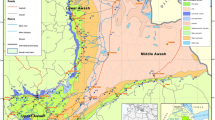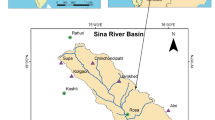Abstract
Drought is one of the most devastating climate disasters. Hence, drought forecasting plays an important role in mitigating some of the adverse effects of drought. Data-driven models are widely used for drought forecasting such as ARIMA model, artificial neural network (ANN) model, wavelet neural network (WANN) model, support vector regression model, grey model and so on. Three data-driven models (ARIMA model; ANN model; WANN model) are used in this study for drought forecasting based on standard precipitation index of two time scales (SPI; SPI-6 and SPI-12). The optimal data-driven model and time scale of SPI are then selected for effective drought forecasting in the North of Haihe River Basin. The effectiveness of the three data-models is compared by Kolmogorov–Smirnov (K–S) test, Kendall rank correlation, and the correlation coefficients (R2). The forecast results shows that the WANN model is more suitable and effective for forecasting SPI-6 and SPI-12 values in the north of Haihe River Basin.









Similar content being viewed by others
References
Abramowitz M, Stegun IA (1965) Handbook of mathematical functions. Dover publications, New York
Adamowski JF (2008) Development of a short-term river flood forecasting method for snowmelt driven floods based on wavelet and cross-wavelet analysis. J Hydrol 353(3–4):247–266
Adamowski J, Sun K (2010) Development of a coupled wavelet transform and neural network method for flow forecasting of non-perennial rivers in semi-arid watersheds. J Hydrol 390(1–2):85–91
ASCE Task Committee on Application of Artificial Neural Networks in Hydrology (2000) Artificial neural networks in hydrology. I: Preliminary concepts. J Hydrol Eng 5(2):124–137
Bacanli UG, Firat M, Dikbas F (2008) Adaptive neuro-fuzzy inference system for drought forecasting. Stoch Environ Res Risk Assess 23(8):1143–1154
Barros A, Bowden G (2008) Toward long-lead operational forecasts of drought: an experimental study in the Murray–Darling River Basin. J Hydrol 357(3–4):349–367
Belayneh A, Adamowski J (2012) Standard precipitation index drought forecasting using neural networks, wavelet neural networks, and support vector regression. In: Applied computational intelligence and soft computing
Belayneh A, Adamowski J, Khalil B, Ozga-Zielinski B (2014) Long-term SPI drought forecasting in the Awash River Basin in Ethiopia using wavelet neural network and wavelet support vector regression models. J Hydrol 508:418–429
Bordi I, Sutera A (2007) Drought monitoring and forecasting at large scale. Methods Tools Drought Anal Manag 62:3–27
Bordi I, Frigio S, Parenti P, Speranza A, Sutera A (2001) The analysis of the Standardized Precipitation Index in the Mediterranean area: large-scale patterns. Ann Geofis 44(5–6):965–978
Box GEP, Jenkins GM (1976) Time series analysis, forecasting and control. Wiley, Hoboken
Bussay A, Szinell C, Szentimery T (1999) Investigation and measurements of droughts in Hungary. Hungarian Meteorological Service, Budapest
Cacciamani C, Morgillo A, Marchesi S, Pavan V (2007) Monitoring and forecasting drought on a regional scale: Emilia-Romagna region. Water Sci Technol Libr 62(1):29–48
Cannas B, Fanni A, Sias G, Tronci S, Zedda MK (2006) River flow forecasting using neural networks and wavelet analysis. In: Proceedings of the European geosciences union
Coulibaly P, Anctil F, Bobée B (2000) Daily reservoir inflow forecasting using artificial neural networks with stopped training approach. J Hydrol 230(3–4):244–257
Dai A, Trenberth KE, Qian TT (2004) A global dataset of palmer drought severity index for 1870–2002: relationship with soil moisture and effects of surface warming. J Hydrometeorol 5(6):1117–1130
Edwards DC, McKee TB (1997) Characteristics of 20th century drought in the United States at multiple scales. Atmos Sci Pap 634:1–30
Garbero A, Muttarak R (2013) Impacts of the 2010 droughts and floods on community welfare in rural Thailand: differential effects of village educational attainment. Ecol Soc 18(4):27
Han P, Wang P, Zhang S, Zhu D (2010) Drought forecasting with vegetation temperature condition index. Geomat Inf Sci Wuhan Univ 35(10):1202–1206
Hayes M, Svoboda MD, Wilhite DA, Vayarkho OV (1999) Monitoring the 1996 drought using the standardized precipitation index. Bull Am Meteorol Soc 80(3):429–438
Karamouz M, Rasouli K, Nazil S (2009) Development of a hybrid index for drought prediction: case study. J Hydrol Eng 14:617–627
Kendall MG (1975) Rank correlation methods griffin. Griffin, London
Keshavarz M, Karami E, Vanclay F (2013) The social experience of drought in rural Iran. J Land Use Policy 30:120–129
Kim TW, Valdes JB (2003) Nonlinear model for drought forecasting based on a conjunction of wavelet transforms and neural networks. J Hydrol Eng 8(6):319–328
Labat D, Ababou R, Mangin A (1999) Wavelet analysis in karstic hydrology part 2: rainfall-runoff cross-wavelet analysis. C R Acad Sci Ser IIA Earth Planet Sci 329(12):881–887
Lane SN (2007) Assessment of rainfall-runoff models based upon wavelet analysis. Hydrol Process 21(5):586–607
Lloyd-Hughes B, Saunders M (2002) A drought climatology for Europe. Int J Climatol 22:1571–1592
Logan KE, Brunsell NA, Jones AR, Feddema JJ (2010) Assessing spatiotemporal variability of drought in the US central plains. J Arid Environ 74:247–255
Mallat SG (1998) A wavelet tour of signal processing academic. Elsevier Academic Press, Cambridge
Mann HB (1945) Nonparametric tests against trend. Econometrica 13:245–259
Marj AF, Meijerink AM (2011) Agricultural drought forecasting using satellite images, climate indices and artificial neural network. Int J Remote Sens 32(24):9707–9719
McKee TB, Doesken NJ, Kleist J (1993a) The relationship of drought frequency and duration to time scales. In: 8th conference on applied climatology, Anaheim, California, pp 179–184
McKee TB, Doesken NJ, Kleist J (1993b) The relationship of drought frequency and duration to time scales. Paper Presented at 8th conference on applied climatology, american meteorological society, Anaheim, CA
McKee TB, Doesken NJ, Kleist J (1995) Drought monitoring with multiple time scales. In: 9th Conference on applied climatology, american meteorological society, Boston, pp 233–236
Mehta S (2014) Statistics topics. ISBN: 978-1499273533
Mishra AK, Desai VR (2005) Drought forecasting using stochastic models. Stoch Environ Res Risk Assess 19(5):326–339
Mishra AK, Desai VR (2006) Drought forecasting using feed-forward recursive neural network. Ecol Model 198(1–2):127–138
Mishra SS, Nagarajan R (2012) Forecasting drought in Tel River Basin using feedforward recursive neural network. In: International conference on environmental, biomedical and biotechnology
Mishra AK, Desai VR, Singh VP (2007) Drought forecasting using a hybrid stochastic and neural network model. J Hydrol Eng 12:626–638
Morid S, Smakhtin V, Bagherzadeh K (2007) Drought forecasting using artificial neural networks and time series of drought indices. Int J Climatol 27(15):2103–2111
Murtagh F, Starck JL, Renuad O (2004) On neuro-wavelet modeling. Decis Support Syst 37(4):475–484
Partal T, Kisl O (2007) Wavelet and neuro-fuzzy conjunction model for precipitation forecasting. J Hydrol 342(1):199–212
Paulo AA, Pereira LS (2008) Stochastic prediction of drought class transitions. Water Resour Manag 22(9):1277–1296
Pearson ES, Hartle HO et al (1972) Biometrika Tables for Statisticians. Cambridge University Press, Cambridge, pp 117–123
Raziei T, Saghafian B, Paulo AA, Pereira LS, Bordi I (2009) Spatial patterns and temporal variability of drought in western Iran. Water Resour Manag 23(3):439–455
Renaud O, Starck J, Murtagh F (2002) Wavelet-based forecasting of short and long memory time series. Department of Economics, University of Geneve
Saco P, Kumar P (2000) Coherent modes in multiscale variability of streamflow over the United States. Water Resour Res 36(4):1049–1067
Smith LC, Turcotte DL, Isacks BL (1998) Stream flow characterization and feature detection using a discrete wavelet transform. Hydrol Process 12(2):233–249
Szalai S, Szinell C (2000) Comparison of two drought indices for drought monitoring in Hungary a case study. In: Vogt JV, Somma F (eds) Drought and drought mitigation in Europe. Kluwer, Dordrecht, pp 161–166
Tabari H, Abghari H, Hosseinzadeh TP (2012) Temporal trends and spatial characteristics of drought and rainfall in arid and semiarid regions of Iran. Hydrol Process 26(22):3351–3361
Thom HCS (1958) A note on the gamma distribution. Mon Weather Rev 86:117–122
Tsakiris G, Vangelis H (2004) Towards a drought watch system based on spatial SPI. Water Resour Manag 18(1):1–12
Wang J, Feng Z, Li H (2013) Identification and comprehensive response strategy to severe water shortage system of Hebei. Science Press, Beijing
Zhang YH, Cai WY et al (2015) Probabilistic analysis of drought spatiotemporal characteristics in the Beijing–Tianjin–Hebei metropolitan area in China. Atmosphere 6(4):431–450
Zhu YH, Drake S, Lu HS, Xia J (2010) Analysis of temporal and spatial differences in eco-environmental carrying capacity related to water in the Haihe River Basins. China Water Resour Manage 24:1089–1105
Zou XK, Zhai PM, Zhang Q (2005) Variations in droughts over China: 1951–2003. Geophys Res Lett 32:L04707. doi:10.1029/2004GL021853
Acknowledgements
Support was provided by the National Science and Technology Support Plan during the 12th Five-year Plan Period of China (Nos. 2012BAC19B03 and 2013BAC10B01) and the Natural Science Fund of China (41201331 and 41071020). It is realized as a part of the Project “Statistical Analysis and Information Extraction of High-dimensional Complicate Data” jointly funded by Scientific Research Project of Beijing Educational Committee (No. KZ201410028030).
Author information
Authors and Affiliations
Corresponding author
Rights and permissions
About this article
Cite this article
Zhang, Y., Li, W., Chen, Q. et al. Multi-models for SPI drought forecasting in the north of Haihe River Basin, China. Stoch Environ Res Risk Assess 31, 2471–2481 (2017). https://doi.org/10.1007/s00477-017-1437-5
Published:
Issue Date:
DOI: https://doi.org/10.1007/s00477-017-1437-5




